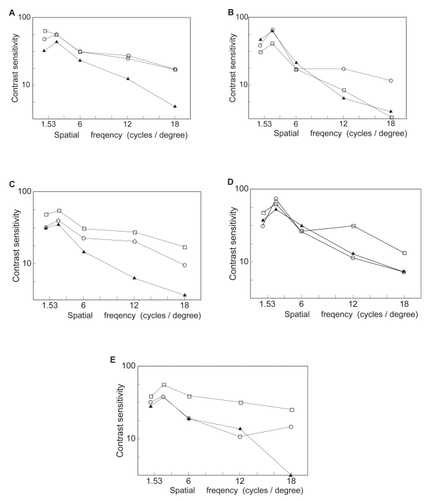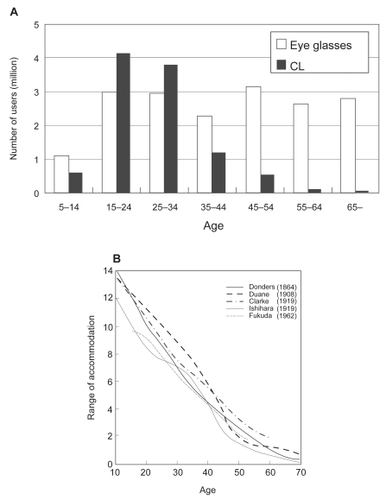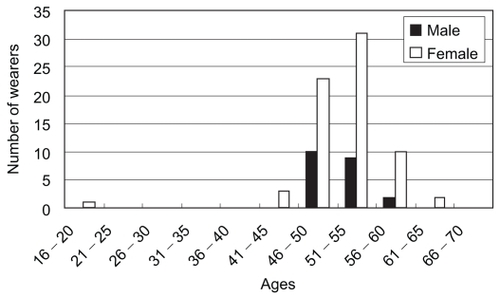Figures & data
Figure 1 Diagram of an alternating vision RGP lens. The upper and lower parts of the lens provide distant and near vision, respectively.

Figure 2 Diagram of a concentric SCL. In this design, distant and near vision are provided by concentric areas of the CL, which are classified as bifocal and progressive multifocal.

Figure 3 Diagram of a nonspherical lens. The posterior surface (or the anterior and posterior surfaces) of the lens is nonspherical, and the central and paracentral parts of the lens provide distant and near vision, respectively. The power changes successively between the two parts.

Figure 4 Diagram of a lens in which the optical axis coincides with the line of sight. In this design, the optical center of the lens is shifted slightly toward the nose so that it coincides with the line of sight. Since convergence and miosis occur at the time of near vision, this design is most suitable for near vision.

Figure 5 Diffractive SCL. There is a refractive part at the center, which is surrounded by many circular diffractive zones. A distant image is formed by refraction at the center, while a near image is formed in the diffractive zone on the inner surface of the lens.

Table 1 Selection of bifocal CLs at the initial prescription
Figure 7 Contrast obtained with various bifocal CL. Results obtained by measurement of contrast while wearing bifocal CL using a multivision contrast tester (MCT8000, Vistec Inc). Distant vision during the daytime (○), near vision during the daytime (●), and near vision at night (▴). Data obtained at the time of wearing glasses were used as control values. A Eye glasses (control); B Simultaneous, Nonspherical type (RGP): Expert®; C Simultaneous, Nonspherical type (RGP): Clair®; D CL in which the optical axis coincides with the line of sight (SCL): E Menifocal soft®; Simultaneous, Concentric type (SCL): ForView®.

Table 2 Results of long-term use of bifocal CL in our department
Table 3A Major bifocal RGP lenses that were initially prescribed. Details of the CLs, number of the eyes, near and distant vision, the addition for near vision (D) and frequency of prescription changes. Visual acuity was measured with a Snellen chart. To analyze the data, each value was transformed to a logMAR visual acuity value. Data are re-calculated to Snellen visual acuity, again.
Table 3B Major bifocal SCLs that were initially prescribed. Details of the CLs, number of the eyes, near and distant vision, the addition for near vision (D) and frequency of prescription changes. Visual acuity was measured with a Snellen chart. To analyze the data, each value was transformed to a logMAR visual acuity value. Data are re-calculated to Snellen visual acuity, again.
Figure 8 A Number of persons using eye glasses and CL in each age in Japan. B Age versus accommodation curve. The number of CL wearers decreases at the age of 35 years or more, and shows a further decrease at the age of 45 years or more in Japanese. It decreases markedly when presbyopia becomes a problem, and the pattern of decrease is very similar to the age versus accommodation curve.

